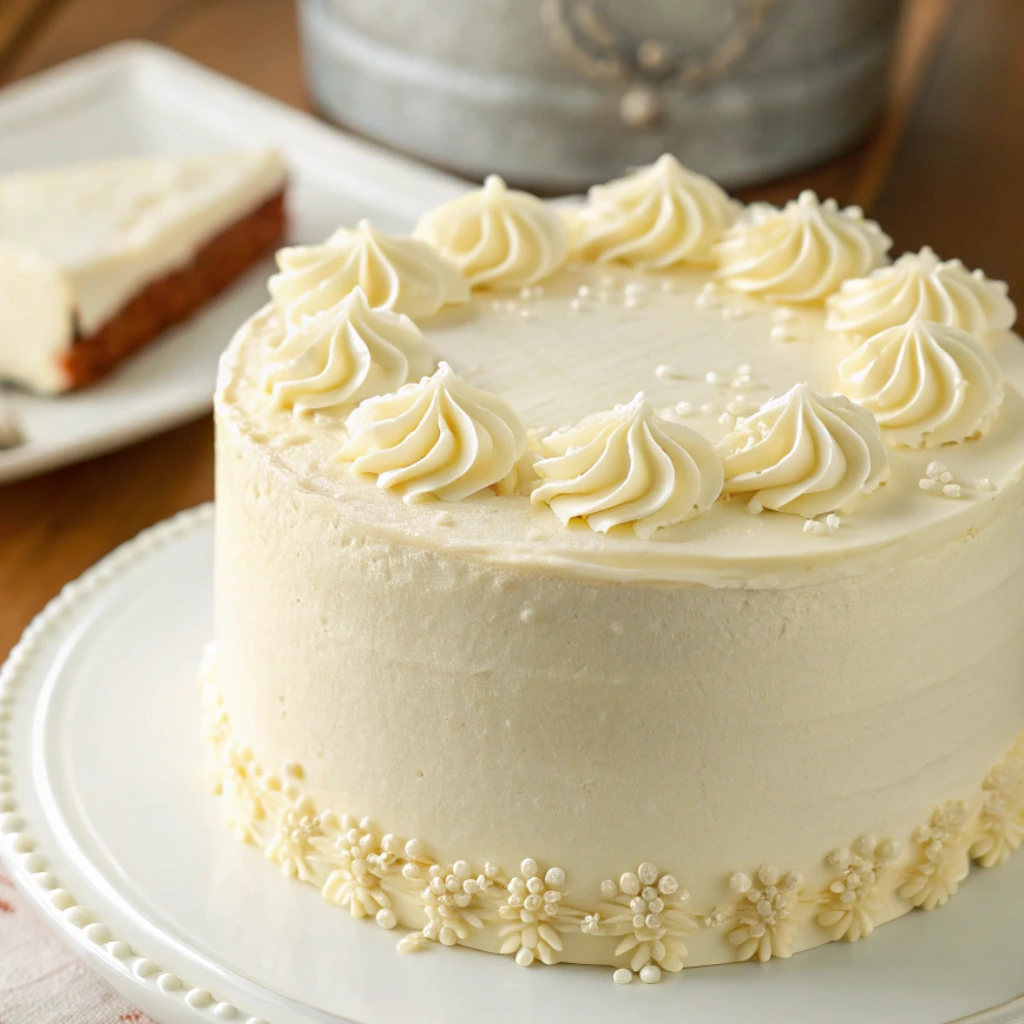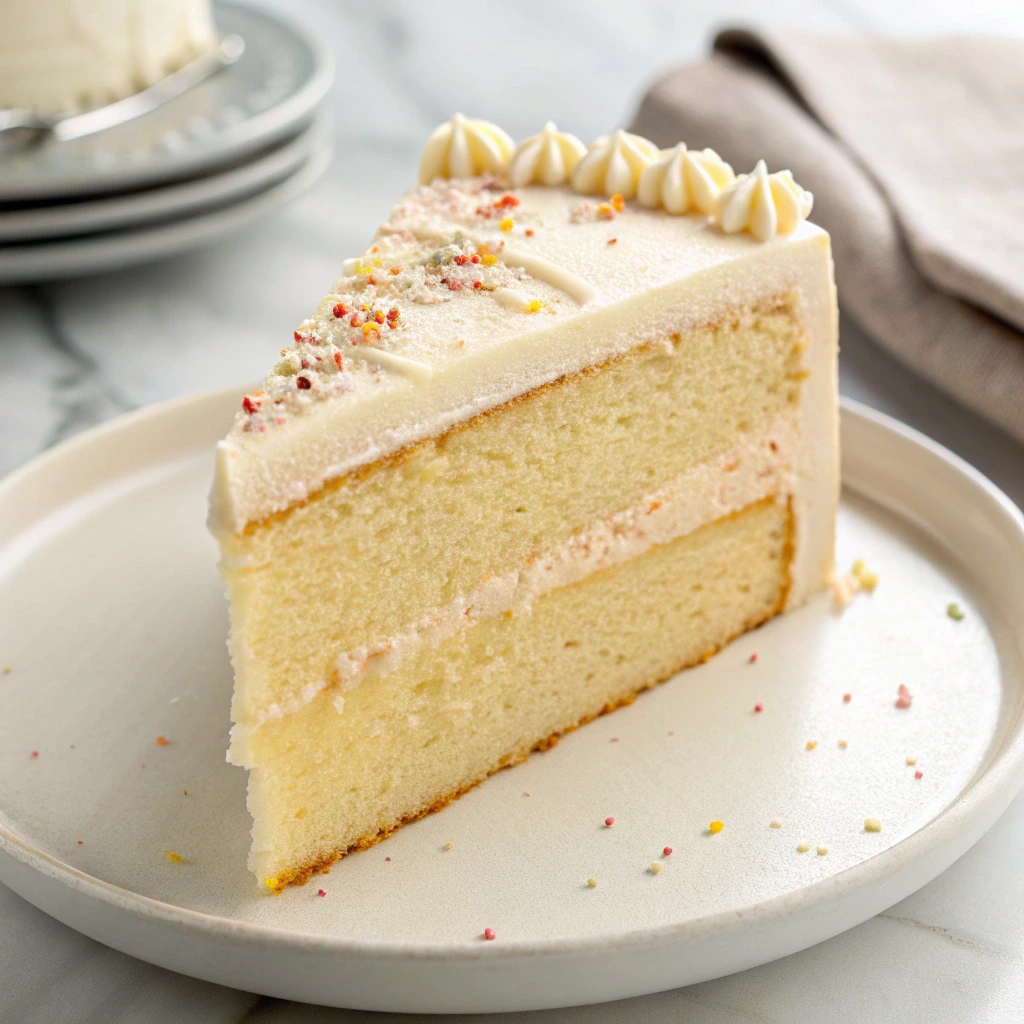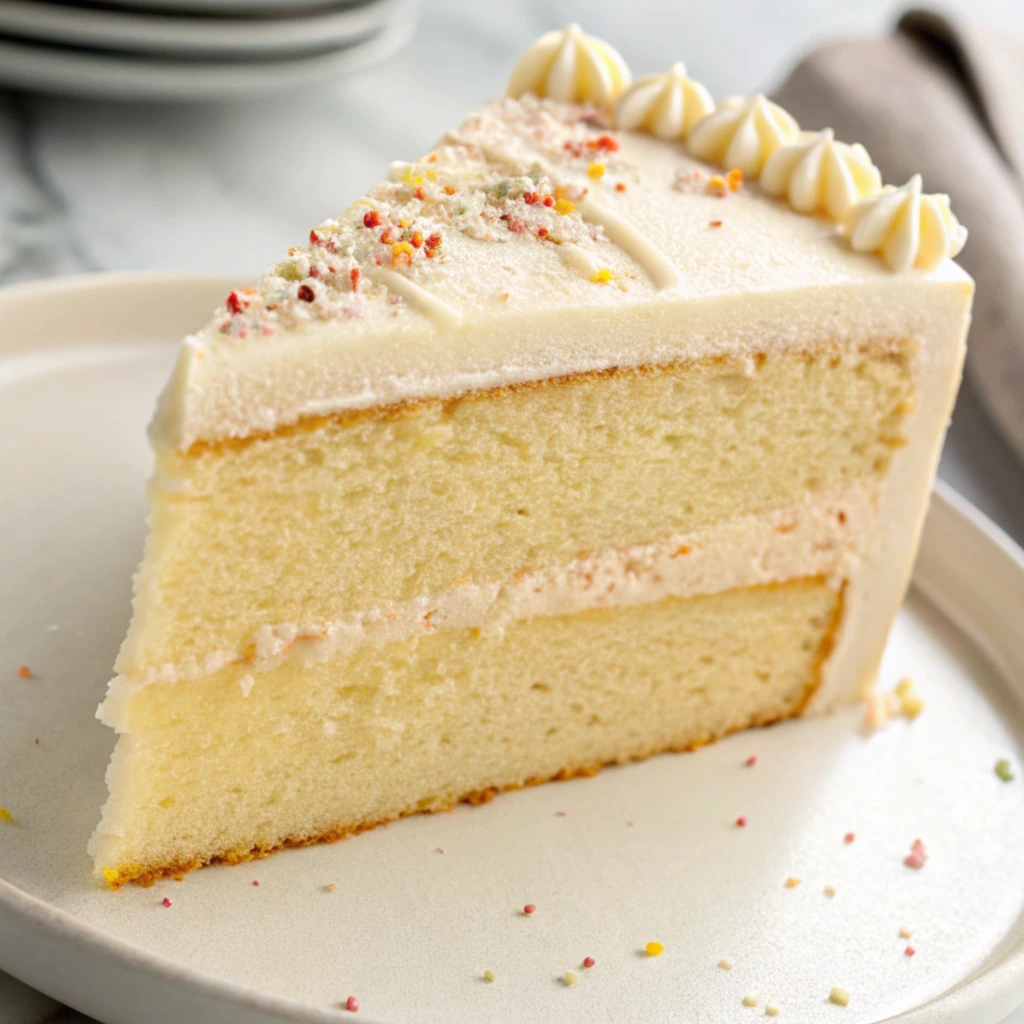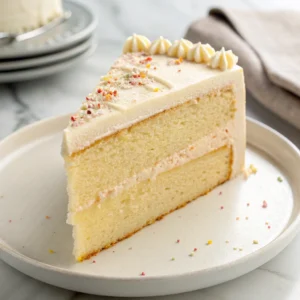There’s something incredibly comforting about the smell of vanilla cake baking in the oven. For me, this cake isn’t just dessert — it’s a warm memory stitched into the fabric of my kitchen life. Years ago, when I first started baking, vanilla cake was my go-to test recipe. I was nervous about baking, often second-guessing measurements and timing. But this cake was forgiving. It taught me patience, the importance of good ingredients, and that sometimes, simple is best. Every time I slice into a vanilla cake, I’m reminded of those early kitchen mishaps—like forgetting to sift flour or overmixing the batter—and how those little mistakes taught me to slow down and listen to the process. This recipe is my invitation to you: to find joy in the basics and make something sweet that feels like home.

Why You’ll Love This Recipe
- It’s straightforward enough for beginners but yields a tender, flavorful cake that even seasoned bakers appreciate.
- Uses pantry staples you probably already have on hand.
- Budget-friendly without compromising on taste or texture.
- Versatile enough to dress up with frostings, fresh fruit, or simply enjoy plain.
- Holds well for leftovers, making it a great choice for baking ahead.
Ingredients You’ll Need
Here’s where I’ve learned that quality matters—especially with simple recipes. For this cake, you’ll want all-purpose flour; I sometimes swap half for cake flour when I want a lighter crumb. Granulated sugar is classic, but occasionally I use a touch of brown sugar to deepen the flavor, especially in cooler months. Fresh, whole milk gives richness that water or skim milk just can’t match. I always reach for real vanilla extract—pure, not imitation—because it’s the heart of the flavor here. Butter, unsalted, room temperature, is my preference over oil; it gives a lovely crumb and flavor, though oil can be a suitable swap in a pinch. Eggs are essential for structure and moisture; large eggs work perfectly. And don’t forget baking powder and a pinch of salt to balance everything out.
- 2 ½ cups all-purpose flour (or 2 cups all-purpose + ½ cup cake flour)
- 2 ¼ teaspoons baking powder
- ½ teaspoon salt
- 1 cup unsalted butter, softened
- 1 ¾ cups granulated sugar (or 1 ½ cups sugar + ¼ cup brown sugar)
- 4 large eggs, at room temperature
- 1 cup whole milk, at room temperature
- 2 teaspoons pure vanilla extract
How to Make It (Step-by-Step Instructions)
Start by preheating your oven to 350°F (175°C). I usually grease and flour two 9-inch round cake pans, but I’ve also used parchment paper with great results. It really helps with easy removal and clean edges. While the oven warms, sift your dry ingredients together: flour, baking powder, and salt. Sifting isn’t absolutely necessary, but it helps avoid lumps and keeps the cake tender.
In a large bowl, cream the softened butter and sugar until it’s light and fluffy. This step takes some patience, and using a stand mixer speeds things up, but a hand mixer or even a strong wooden spoon can do the job. The key is to not rush — the creaming process traps air that gives your cake lift.
Add the eggs one at a time, beating well after each addition. This helps the eggs fully incorporate and keeps the batter smooth. If you add them all at once, you might end up with a curdled batter. Then mix in the vanilla extract.
Here’s where I always remind myself—and you—not to overmix when you add the flour and milk. Alternate adding the dry ingredients and milk in three parts, starting and ending with the dry. Use a gentle folding motion or mix on low speed just until combined. Overworking the batter will develop gluten and make the cake dense instead of light.
Pour the batter evenly into your prepared pans. Tap the pans gently on the counter to release any large air bubbles. Pop the cakes into the oven and bake for about 30–35 minutes. Start checking around 28 minutes by inserting a toothpick in the center—if it comes out clean or with just a few moist crumbs, it’s done. Avoid opening the oven door too often to keep the temperature steady.
Once baked, let the cakes cool in their pans for 10–15 minutes before transferring them to a wire rack to cool completely. Patience here is key—frosting warm cake leads to a messy finish.

Expert Tips for the Best Results
Over the years, I’ve realized that the difference between a good vanilla cake and a great one often comes down to the little things we sometimes overlook. For instance, the temperature of your ingredients plays a surprisingly big role—room temperature eggs and milk blend more evenly, ensuring your batter doesn’t curdle or separate. Also, don’t rush the creaming of butter and sugar; that light, fluffy texture really sets the stage. Another nugget I keep close: alternate your wet and dry ingredients to avoid overmixing and keep the crumb tender. And don’t skip the step of gently tapping your pans before baking—this helps prevent big air pockets that can cause uneven texture. Lastly, don’t stress if your cake tops aren’t perfectly flat; a simple level with a serrated knife or a creative frosting technique can make everything look beautiful.
Variations & Substitutions
I’m a fan of tweaking this vanilla cake depending on what’s on hand or the mood I’m in. Once, I swapped half the milk for buttermilk and found the tangy richness gave the cake a delightful depth I hadn’t expected. On a few occasions when I ran out of butter, I tried using oil with some melted butter mixed in—results were still tender but less rich, which was fine for a quick dessert. If you’re avoiding eggs, I’ve experimented with applesauce or yogurt as replacements, though the texture shifts slightly to denser and more moist, which I found works well if you’re frosting heavily or using the cake as a base for trifle. I’ve even folded in a handful of fresh berries or a teaspoon of lemon zest to brighten things up. These little changes keep the recipe feeling fresh and approachable.
Serving Suggestions
Vanilla cake is such a lovely blank canvas. I often keep it simple with a dusting of powdered sugar and fresh berries on top, especially for casual afternoon tea or a family gathering. For celebrations, a smooth layer of buttercream or cream cheese frosting is classic and always well-received. I’ve served it with a scoop of vanilla ice cream or a drizzle of homemade fruit sauce for a cozy finish after dinner. This cake fits beautifully on a birthday table, for holiday treats, or just when you need a sweet pick-me-up with your morning coffee. It pairs wonderfully with light, fruity drinks or a cup of robust black tea. No matter the occasion, this cake is reliable, comforting, and sure to bring smiles.
Storage & Reheating Instructions
I usually store leftover vanilla cake tightly wrapped in plastic wrap or in an airtight container at room temperature if I plan to eat it within two days. For longer storage, I freeze slices wrapped in foil and a freezer bag, which keeps the cake fresh for up to three months. When I want to enjoy it again, I let it thaw at room temperature, which preserves the moist texture best. If you’re in a hurry, a few seconds in the microwave—just 10 to 15 seconds—revives the softness without drying it out. I avoid reheating in the oven because it can dry the cake out. I’ve found that vanilla cake keeps its flavor well, but the crumb is always at its best fresh or gently reheated.
Recipe FAQs (Answered by Clara)
Can I make this cake ahead of time?
Absolutely. I often bake it the day before and keep it wrapped tightly. It actually tastes better the next day when the flavors have had time to meld.
What if I don’t have cake pans?
You can use an 8×8-inch square pan or even cupcake tins. Just keep an eye on the baking time; smaller portions bake faster.
Can I use a different type of milk?
Whole milk works best for richness, but I’ve used almond milk or oat milk with good results. Just expect a slight change in flavor and texture.
How do I avoid a dry cake?
Don’t overbake and make sure to measure flour correctly—too much flour dries out the crumb. Also, gentle mixing and using room temperature ingredients help keep moisture locked in.
Can I add frosting or should I serve it plain?
Both work wonderfully. This cake’s mild flavor pairs well with many frostings, but it’s also delicious simply dusted with sugar or topped with fresh fruit.

Conclusion
I hope you’ll give this vanilla cake a try and discover the joy I found in its simplicity and warmth. Baking is as much about the experience as it is about the final product, and I love imagining you in your kitchen, making this recipe your own. If you do bake it, please drop a comment to share your thoughts or any tweaks you’ve made—I’m always eager to hear your stories. Here’s to many sweet moments and memories made around the kitchen table.

Vanilla Cake
Ingredients
For the Vanilla Cake:
- 2 ½ cups all-purpose flour
- 2 ½ tsp baking powder
- ½ tsp salt
- 1 cup unsalted butter softened
- 1 ¾ cups granulated sugar
- 4 large eggs
- 1 tbsp pure vanilla extract
- 1 cup whole milk or buttermilk for extra richness
For the Vanilla Buttercream Frosting:
- 1 cup unsalted butter softened
- 3 ½ – 4 cups powdered sugar
- 2 tsp vanilla extract
- 2 –4 tbsp heavy cream or milk
- Pinch of salt to balance sweetness
Instructions
Bake the Cake:
- Preheat oven to 350°F (175°C). Grease and flour two 9-inch round cake pans (or line with parchment).
- In a medium bowl, whisk together flour, baking powder, and salt.
- In a large mixing bowl, cream together butter and sugar until light and fluffy (about 3 minutes).
- Beat in the eggs one at a time, then add vanilla extract.
- Alternate adding flour mixture and milk to the wet ingredients, starting and ending with the flour. Mix until just combined—do not overmix.
- Divide batter evenly between prepared pans and smooth the tops.
- Bake for 28–32 minutes, or until a toothpick inserted in the center comes out clean.
- Cool in pans for 10 minutes, then remove and cool completely on wire racks.
Make the Frosting:
- Beat softened butter until creamy.
- Add powdered sugar gradually, mixing until combined.
- Mix in vanilla and 2 tablespoons cream/milk. Add more if needed to reach desired consistency.
- Beat until fluffy and smooth (about 2–3 minutes).
Assemble the Cake:
- Once cake layers are fully cooled, frost the top of one layer, add the second layer, and frost the top and sides.
- Decorate with sprinkles, fruit, or piping as desired.
Notes
- Room temperature ingredients help everything mix smoothly.
- You can make this as a sheet cake, cupcakes, or layered cake.
- Add a layer of jam or fruit filling for a twist.
- Store leftovers covered at room temperature for up to 3 days or refrigerate for longer freshness.
- Want it extra moist? Substitute half the milk with sour cream or yogurt.

